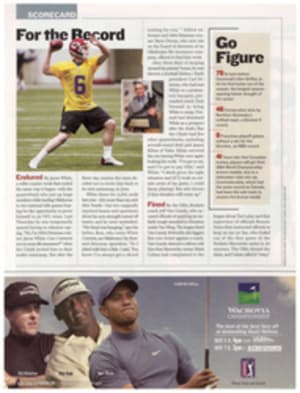
Analyzing Annika
SI asked instructor Mitchell Spearman, who for years has observed Annika Sorenstam at practice, to break down the elements of her game, tee to green. Spearman teaches at Manhattan Woods Golf Club in West Nyack, N.Y., and is a Golf Magazine Top 100 Teacher who has worked with such tour pros as Nick Faldo, Greg Norman and Laura Davies.
• HER MENTAL APPROACH Annika dominates because she has no weaknesses or idiosyncrasies. She's also the most even-keeled superstar I've ever seen. She has the same focused demeanor whether she's three under par or three over par. Moreover, most pros change their swings simply for the sake of change, or in a usually fruitless effort to improve. Annika won't change unless she needs to. One thing she has tweaked over the years is her workout regimen, and that has made her much stronger and given her a huge distance advantage over her foes.
• HER SWING There's a serenity and simplicity to Annika's swing, which is the same with every club. She keeps her spine straight and her hands quiet. The club travels on the same plane in the backswing, the downswing and the follow-through. That's how she hits more shots on or close to the center of the club face than any man or woman in the world.
At setup she is well-balanced and athletic with even weight distribution. Each body part looks natural and relaxed. Her grip is beautiful and surprisingly neutral. Annika's hands look as if they're molded to the club.
• OFF THE TEE [Sorenstam ranks second this year in average driving distance, 272.9 yards, and tied for 95th in driving accuracy.] Annika's driving has improved more than any other aspect of her game. Her tee shots get great air time and release hard after hitting the ground. On the backswing she sweeps the club smoothly from the ball and doesn't set the wrists too early. She makes the club sit beautifully at the top and points it down the fairway and parallel to the target line. In the downswing and through impact, the ball simply gets in the way of a flowing and powerful motion. To maintain balance, Annika keeps her head down slightly longer with the driver than with her irons.
• THE IRONS [first in greens in regulation] Annika's distance control is amazing because her strikes are so consistently square. Most impressive are her scoring irons--six through nine--and she is perhaps the best player with these clubs since Curtis Strange in the late 1980s. She keeps her hands passive, and there is no flicking at the ball through the impact zone. When practicing, Annika peppers a flag with an iron for 15 minutes and then takes another iron and zeros in on another flag. She'll do this with every iron in her bag.
• SHORT GAME/SAND PLAY [tied for 31st in sand saves] Annika has told me that she's trying to use a lot more spin and loft around the green rather than bump-and-runs. She learned to appreciate this more creative style of chipping and pitching by playing against men and practicing with Tiger Woods. Instead of rolling the ball to a flag perched on a ledge, Annika will now favor the aggressive play by using a sand wedge to nip the ball with lots of spin, so it lands and quickly bites.
• PUTTING [tied for 28th in putts per round; tied for fourth in putts per greens in regulation] This is the weakest part of her game because there's no pressure for her to be a great putter. Annika hits so many greens and her approaches are so close to the hole that she doesn't have to putt phenomenally. She's a shoulder stroker who sets up all square to the target, rocks back and through, and makes super solid contact. She's had to work hard on the greens to be good--and anyone who averages 4.64 birdies a round is a good putter.
COLOR PHOTO
MARK J. TERRILL (LEFT)
MUSCLING UP
Once skinny (left, in '02), Sorenstam has become longer and stronger thanks to intense workouts.
COLOR PHOTO
TODD BIGELOW/AURORA
[see caption above]

